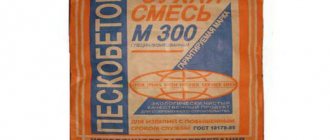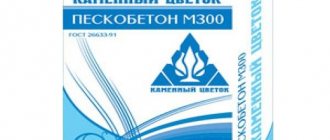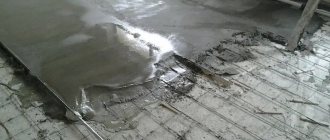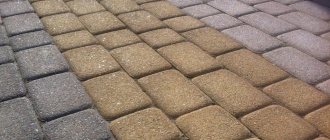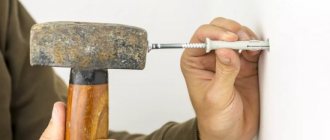Sand concrete is a modern building material composed of a certain amount of Portland cement, sand and other additives that are added to the composition. All dry construction mixtures are manufactured in accordance with GOST 28013-98, which determines their technical characteristics, which will be discussed below.
Purpose of sand concrete
The material has high strength, resistance to temperature influences and corrosion, and quickly sets and hardens, so it is used in the following cases:
- Creation of concrete screeds and monolithic floors with high wear resistance.
- Sealing joints, leveling bases made of cement-sand or concrete compositions.
- Repair of horizontal and vertical concrete surfaces, reconstruction of foundations, installation work of varying complexity.
- Laying leveling screed in rooms with a normal level of atmospheric humidity (living rooms, domestic, administrative buildings, outbuildings).
- Facade work, installation of basement finishing materials.
The characteristics of Rusean M300 are suitable for construction work in the construction of domestic premises, industrial facilities of various sizes and complexity, arrangement of basements, floors in the basement. The properties of the material allow it to be used both for internal tasks and for work on facades and foundations.
The use of sand concrete in construction
Sand concrete is used for:
- brickwork;
- foundation arrangement;
- sealing joints and seams;
- for screeds and floors;
- production of monolithic slabs and sand concrete blocks;
- embedding of reinforced concrete structures.
High-quality sand concrete is produced at special enterprises with appropriate equipment. First of all, the recipe is approved taking into account the proportions. Next, all the constituent substances are sent to a concrete mixing plant and mixed. The finished mixture is packaged in paper bags.
Material characteristics
The manufacturer of the mixture monitors the quality of the product, so the sand concrete received a certificate of conformity. The text of the document can be found on the official website: certificates. Full characteristics of the material are shown in the table:
| № | Characteristic | Parameter |
| 1 | Color | grey |
| 2 | Application area | rough alignment |
| 3 | Maximum fraction, mm | 5 |
| 4 | Mixture consumption per 1 m² with a thickness of 10 mm, kg | 20 — 22 |
| 5 | Water consumption per 1 kg of dry mixture, l | 0,12 — 0,15 |
| 6 | Mobility of the mortar mixture | PC3 |
| 7 | Bulk density of the mixture, kg/m³ | 1500 — 1550 |
| 8 | Density of the solution, kg/m³ | 2100 — 2200 |
| 9 | Layer thickness, mm | 50 — 150 |
| 10 | Adhesion to concrete, after 28 days, MPa | 0,4 |
| 11 | Work temperature | from +5°C to +25°C |
| 12 | Viability of solution, hour | 2 |
| 13 | Possibility of walking, hour | 48 |
| 14 | Operating temperature range | -35°C to +40°C |
| 15 | Frost resistance | F50 |
| 16 | Compressive strength, MPa | 30 |
| 17 | Expiration date, months | 6 |
| 18 | Bag weight, kg | 40 |
Method of use
First, preparatory work is underway.
The surface on which the sand cement solution will be applied must be thoroughly cleaned of any debris, grease stains removed, and holes and cracks sealed.
Using a level, beacons are set that will allow you to level the solution and obtain a strictly horizontal surface.
The dry sand cement mixture is diluted with water. For one part of the mixture you need to take 5 parts of water. Mix with a mixer until a plastic, homogeneous mass is obtained.
The base must be moistened with water immediately before pouring.
The prepared solution is poured into the prepared surface between the beacons. Its quantity is determined so that it is convenient to work.
Complies with the rule. After 36 hours, tiles can be laid on the floor. It will dry completely in seven days.
Advantages of the material
The advantages of the composition include the following qualities:
- Versatility of application, the ability to be used both for solving everyday problems and for meeting large construction needs.
- The material is insensitive to low temperatures.
- Sand concrete is not afraid of high humidity.
- Hardening occurs 2 days after installation; the work itself can be carried out even at zero air temperature.
- Resistant to delamination and corrosive effects.
- Easy to prepare the mixture and install it, the solution can be used within 2.5-3 hours from the moment of adding water.
- The finished surface is resistant to shrinkage and serious mechanical stress: the structure made from M300 can withstand a constant pressure of 300 kg per square centimeter.
- Affordable price.
Varieties
- Sand concrete M300 "Finstroy" is intended for initial rough leveling of floors, eliminating seams between concrete slabs, and for pouring foundations. It is better to use in rooms with not very high humidity and little mechanical stress on the floor surface. These are mainly residential premises and industrial construction. Fill with a layer of 10 to 15 mm. If you use reinforcing steel in your work, you can increase the layer thickness to 10 cm. The weight of the bag in which M300 sand concrete is sold is 50 kg. Price - 85-106 rubles.
- Sand concrete M300 BESTO consists of Portland cement, quartz sand, and superplasticizer C-3. Used for floor screeds, paths, floors. It is also used in the manufacture of expanded clay. The price of the bag is 140 rubles.
- Sand concrete M300 NOVAMIX is a very plastic type of mixture of such material as sand concrete M300. The price of the bag is 85-105 rubles.
- Accelerated hardening sand concrete, bag price - 70-85 rubles.
- Sand concrete M300 “Stone flower”. Complete drying time is one day. The mixture can be used at temperatures from 35 degrees Celsius to 5 degrees Celsius. The maximum layer thickness is 10 cm, 15 mm is the minimum thickness of the solution that M300 sand concrete can have. Consumption - 15-17 kg per square meter.
- Sand concrete M300 Quick Beton (“fast concrete”). The name speaks for itself. It is used for pouring durable conventional and heated floors and building concrete walls. Has a good price/quality ratio. Shelf life - 6 months. Adhesion (ability to stick to a surface) - 0.3 mPa. The temperature range at which the products can be used is from 50 degrees Celsius to 70 degrees below zero.
Preparing the mixture
Before mixing the solution, it is necessary to prepare the surface on which it will be applied: regardless of the purpose (repairing the foundation, screeding, leveling or finishing walls), it is necessary to clean the coating from dirt, debris, traces of oil and other organic residues.
If you do not do this, the degree of adhesion strength will decrease. Afterwards you will need to seal joints, recesses, irregularities and cracks, if there are any on the surface.
When working with a base that has a high degree of absorption, you will need to treat it twice with a primer.
The process of preparing the mixture is quite simple. For 1 kg of dry matter there is 0.15-0.16 liters of water, and the liquid must be at a neutral temperature. The solution is mixed manually or using a mixer until it becomes homogeneous and turns into a mass with high plasticity without lumps.
The finished composition is left untouched for 7-10 minutes , then mixed again, after which the product can be used for repairs or construction.
As a rule, the solution is poured onto the selected base and distributed manually in an even layer using a construction trowel. You can use a rule to level the layer. At the end of the procedure, the sand concrete is compacted so that the layer takes on the required density when hardening.
The solution sets after 5-6 hours , but hardening, after which the surface can be stepped on, is achieved only after 2 days .
How to choose the best sand concrete
The quality of sand concrete products directly depends on the quality of the material. Strength is determined by the brand of Portland cement, and the amount of shrinkage is determined by the sand fraction.
Here are some general selection rules:
- Choose mixtures from a trusted manufacturer.
- Pay attention to the date of manufacture. Sand concrete contains cement, the properties of which weaken with each month of storage.
- Assess the mixture visually. High-quality sand concrete can pick up moisture from the air and form lumps; poor quality, with low cement content, will crumble.
- If you are not sure about sand concrete, buy some and do a test batch.
What to do if the floor has level differences?
In this case, several measurements of the thickness of the screed are made, the arithmetic average is calculated and used to find the volume of the screed. Another option is to divide the screed into segments in accordance with differences in thickness and calculate the volume for each segment separately.
For more accurate calculations, you can make a test casting. After mixing a small amount of solution, it is poured into a liter plastic bottle. Knowing how much dry mixture was used to produce a 1-liter casting, you can multiply this number by 1000 and find out how much sand concrete is required to produce one cubic meter of concrete. It remains to find out how much concrete is required and calculate the required amount of dry mixture.
When installing heated floors, a special plasticizing and compacting additive is indispensable, with which it becomes easier to level the floor and obtain a perfectly flat, smooth surface.
Consumption per 1m²
To calculate the consumption of sand concrete per square meter, you need to take into account the purpose and volume of work. When building a foundation, it is necessary to determine the required mass of the mixture, and before performing plastering work or installing a screed, it is necessary to find the size of the area.
On average, per square meter of total area requires from 20 to 22 kg of dry mixture, if the thickness of the laid layer is 10 mm . When calculating, it is necessary to focus on the type of work (it takes more material to create a durable screed than to plaster or repair surfaces).
Price and selection options
When choosing M300 sand concrete (see technical specifications, price), you should contact trusted manufacturers. There are many brands on the domestic market that have decent quality. For example, “Stone Flower” sand concrete, whose technical characteristics are not inferior to foreign analogues, can become a worthy choice. Sand concrete M300 “Rusean” has earned good reviews.
The average cost of one bag of the finished mixture is 170 rubles. This amount will have to be paid for 50.0 kg of sand concrete.
In conclusion, I would like to note that the introduction of high-grade material is not always advisable . If you plan to carry out internal plastering work, install a rough screed, seal cracks and seams, you can use M150 sand concrete, the technical characteristics of which fully satisfy the needs of such repair and construction work.
The practical use of sand concrete M-300 when pouring screed is shown in the video:
Preparing the surface for laying laminate
When renovating a bathroom, the floor is screeded with sand concrete. It is convenient to lay tiles on it. Having already made a screed larger than 3 mm, you will really feel the cost savings. In other cases, the “self-leveling floor” technology is used.
Let's say, having removed wooden floors, you decide to replace them with parquet boards or laminate. To do this, you need to make a screed 15 centimeters thick. The technology is the same as described above.
The floor covering can be laid after seven days from the date of production of the screed.
The basic method for calculating the required amount of sand concrete mortar
Professional and private builders are able to calculate how much sand concrete is needed for 1 cubic meter of concrete. After all, such building material is one of the most important components at various stages of repair. The costs of building materials depend on the quality of raw materials. The sand concrete mixture includes the following components:
- a special chemical substance that has high strength and astringent properties - first grade Portland cement;
- sand with a fraction size of no more than 3 millimeters;
- plasticizers, which have the properties of increasing moisture resistance and strength of building materials;
- In order to improve the properties, granite powder is added to the solution.
How many bags of sand concrete are in 1m3? The mixtures are sold in prepackaged packages weighing 25, 40 and 50 kg. This building material is a type of heavy concrete, for this reason the mass of one m3 is approximately 2.4 tons. Using special calculations, when the consumption of sand concrete is 20 kg per 1 square meter, with a layer thickness of 1 cm, then the quantity is calculated using the following formula:
- the volume of a forty kilogram bag is divided by 20 kg, resulting in 2 cm. In order to process 100 cm/2 cm of area, 50 bags will be needed;
- if the volume is 50 kg, then in order to treat an area of 1 m2 you will need 40 packages.
Before determining the required amount of sand concrete per 1 m3 of solution, it is recommended to take into account the condition of the surface layer, the required mixture proportions and the thickness of the coating.
It is recommended to determine this using the following parameters: 1 m3 of sand concrete has a weight of 2400 kg, which must be divided by the package weight of 40 kilograms. The total is:
- 0.010 cubic meters in a 25 kg sand concrete bag;
- 0.017 cubic meters in a 40 kg sand concrete bag;
- 0.021 m3 per 50 kg package.
Types of compositions and requirements
Despite the fact that any CPS composition includes cement and sand, the final characteristics of the solution can vary greatly. The main parameter is strength, which depends on the ratio of components. The level of strength and resistance of the cement-sand mixture to various influences depends on the scope of application of the solution. Therefore, for different jobs, the DSP mixture is prepared according to a specific recipe.
Types
The proportion of cement and sand affects the characteristics of the mixture. As a rule, one brand of cement is used in conventional mortars. But the brand of cement is not the same as the brand of mortar. So, you can make a cement-sand mortar M150 or M300 from it, taking the binder in a certain volume. On the other hand, for the required grade of cement, grades of cement are taken an order of magnitude higher. The binder is supplied in bags of 25 kg or 50 kg.
Main brands of cement-sand mixtures:
- M100 – the greatest strength, from M200-M500 cement, with a certain volume of sand.
- M200 is the most common type of mixture, suitable for creating surfaces and paths in everyday life, withstands light loads, dries quickly and is not demanding on conditions.
- M300 - floor slabs and foundations of good strength are made from mortar.
- M400 - durable concrete prepared on the basis of M400/M500 cement, used for multi-storey construction, reinforced concrete floor slabs, etc.
- M500 is the most durable concrete that is used in private housing construction (there are also grades M600, M700, but they are prepared for special objects). Withstands high loads, retains its original properties for many years, and is not afraid of external negative factors.
In addition to the above, there are also intermediate grades - this can be a cement-sand mixture M 150, M250, M350, etc. But their characteristics do not differ significantly from those of the main grades of concrete.
Supplements
Before diluting cement with sand (choose the correct proportions, measure everything), you should think about the possibility of using additives that change the properties of the mixture. Additives are introduced into the composition to adapt the mixture to the required conditions and increase/decrease certain indicators. Thus, using additives, you can even obtain liquid glass used for plaster.
Dry cement mixtures, as a rule, do not need modification, but they are also more expensive. But if you decided to prepare the DSP yourself, then the list of possible additives and their properties will come in handy.
What can be added to the sand-cement mixture:
- PVA - makes the solution more plastic and increases adhesion to other materials. Before starting work, you need to select the correct proportions for the cement mortar.
- Lime - only slaked lime is used. The additive slightly increases strength and vapor permeability, but requires strict adherence to the ratios. Most often, lime is added to plaster solutions.
- Graphite and carbon black do not affect the physical properties of DSP, but are relevant in the form of dyes.
- Detergents - improve the plasticity of the solution, are introduced into the mixture after water in exact proportions.
You should think about additives before mixing the mixture, since not all substances can be added after adding water to the composition - some only at the stage of mixing the dry ingredients.
Choosing a brand of sand concrete for floor screed
Depending on the composition of the mixture, sand concrete is produced in different grades (that is, different strengths). The minimum strength is M100, the maximum is M500. What type of sand concrete is needed for floor screed depends on how the floor will be used.
- M100 and M150 for screeds in most cases have insufficient strength; they are used more often for plastering walls. This mixture can be used to make flooring in utility rooms or in the country house. Its strength is more than enough to move people and animals, but not for transport. In a house, such a screed can be done if linoleum or carpet is simply laid and there is no heating.
- According to the recommendations of manufacturers, for laminate, vinyl tiles (art vinyl), parquet, parquet boards, ceramic tiles, porcelain stoneware, the base should have a strength of M200 or M250. Therefore, under these types of coatings, a screed of sand concrete of the appropriate brand is made.
The grade of sand concrete for floor screed is determined by the type of floor covering and how the floor will be used - Pouring screed over a heated floor (water or electric) is recommended by a brand no lower than M250. M300 is also possible. For normal heat transfer there must be sufficient density, which is what characterizes concrete of higher grades. The second point is that there must be a sufficiently strong ceiling over the flexible water heating pipes to prevent sagging and sagging under load.
- M300 - this strength can be used if a high load is provided. For example, when laying blocks or panels of multi-story construction, when pouring the foundation of a private house. For a non-heated floor in a private home, such strength is excessive. Perhaps for a garage where heavy vehicles will move. Less durable concrete can also withstand passenger cars. Sand concrete M300 can also be used for external work - for formwork around the house, for example. It is also suitable for pouring a platform for a car and for constructing concrete paths. It is usually frost-resistant enough to last for a sufficient number of years.
High-quality mixtures are used to fill the foundations of multi-story buildings. In private construction, it is not advisable to use a grade higher than M300 - There is simply no place to use concrete higher than M300 in private construction. This level of strength will not be in demand. And since the price increases with the increase in brand, there is no need to spend extra money.
In general, parquet used to be laid on a screed with a strength of M75 or even M50. Why are the requirements higher today? Because previously they used bitumen mastic. Its strength is close to these types of concrete. Modern glue, on which parquet or parquet boards are glued, has much higher strength. In order for the coating to stick and not move away from the base, the strength of the adhesive and the base should not differ by more than 50 units. Since the glue generally has a strength of M200 or M250, the base is required to be the same. Therefore, under the parquet we use sand concrete for floor screed M200 or M250.
The same applies to the floor on which ceramic tiles or porcelain stoneware are laid. Tile adhesive also has high strength. Therefore, the screed under the tiles should be made of sand concrete of a fairly high grade - M200 and no lower.
Instructions for use
Knowing the characteristics of the etalonstroy building mixture, you can understand whether it is suitable for specific types of work. If you choose this sand concrete, you need to know how to use it and what to follow during the work process.
First you need to prepare the surface of the floors, clean them of dirt and be sure to dry them. When there are cracks and deformations on the surface, they need to be eliminated. Before pouring, be sure to wet the surface to be poured.
Then you can start stirring the solution and pouring the surface to be treated.
It is very simple to prepare the solution. The basic instructions for using the standard are on the bags, so this should not be difficult. You need to pour the dry mixture into a concrete mixer or mixing container with a mixer, then simply pour in the required amount of water and mix the mixture until a homogeneous, plastic consistency is obtained. Water consumption according to the standard is 1.6-2.0 liters per 10 kg of sand concrete.
You need to work with the prepared solution within 2 hours after mixing. After pouring sand concrete, after 48 hours you can check the strength of the poured surface, but it can be finally measured after one month. In the process of gaining strength of sand concrete, it is necessary to comply with the required ambient temperature conditions. If the air is cold, this process will take longer.
The hardening period and duration of strength gain of sand concrete M300 Standard depends on the air temperature.
How to breed
Each specific composition of sand concrete, like any other dry building mixture, is developed and calculated. The packaging or instructions must indicate the amount of water required for mixing. And when a new batch of sand or cement, crushed stone is received, the mixture is retested and checked. If there are significant changes, adjustments are made to the accompanying documents. At least that's how it should be.
So, when kneading, it is very advisable to strictly observe the proportions, literally down to the gram. This is if you want a guaranteed result. All the advice like “add more water” or “pour less water” can lead to the concrete not setting at all or crumbling. Or there will be so many cracks that operation will be problematic.
To choose sand concrete for floor screed, look at the characteristics
To ensure sand concrete is of normal quality, first pour water and liquid additives into the container, and then gradually add dry components. In this case, it is guaranteed that there will be no dry pieces in the corners/edges of the container. And one more thing: the water is only clean, without any impurities.
You should also not add cement. It only seems to non-professionals that the more cement, the stronger the concrete will be. It will be stronger if the proportions are respected and high-quality cement is used. But exactly in the quantity that is needed. To gain strength and for the cement to crystallize, a certain amount of water is required. Both its excess and its deficiency reduce the quality of concrete. So the proportions of water and cement should not be violated. If you need a more plastic solution, it is better to add a plasticizer. And also strictly according to the recommendations. It’s even better to immediately take more plastic sand concrete. If more time is needed for installation (due to lack of skills, for example), choose compositions with a longer pot life of the solution. This parameter is also indicated in the specification.
Expansion joints
If the load on a concrete floor exceeds its strength, it collapses. Cracks also appear in the inner part when drying and under the influence of temperature changes. To ensure fewer cracks, you need to cut special seams, which are called expansion joints.
The floor area is divided by seams into squares or similar shapes. In long buildings, the seams are cut at a distance equal to the width of the screed. On sites that are more than three meters wide, you need to make a longitudinal seam in the center. Doors and outside corners also need seams to prevent cracks.
When making a screed over more than one day (in pieces), you need to make construction seams.
All seams are cut to a third of the width of the screed. In this case, the concrete will crack all the same, but it will do so under your guidance in the direction you set.
Choosing a sand concrete manufacturer for floor screed
Having decided on all the parameters, you need to make the last, and perhaps the most difficult, choice. You need to decide which company to buy sand concrete from. There may be a dozen or more manufacturers in large specialized stores. It's easy to get confused.
There's really not much difference. It is important not to fall for a fake that was mixed up in the garage. This usually affects brands with a well-advertised name. If you know what the original packaging should look like, or the seller is trusted, you can use well-known brands. But regional factories are safer in terms of counterfeiting. Their quality is no worse, and there are very few fakes.
How to choose a manufacturer... Based on reviews and experience in using other mixtures
Another selection criterion is “heredity.” If you plan to pour a leveling screed over a regular screed, it is better if they are from the same manufacturer. In this case, there will be no questions about product compatibility. Then it’s better to buy everything at once - both leveling mixtures and sand concrete for floor screed.

